Best Dogs Skin Allergies Treatment & Natural Relief Tips!
Caring for dogs with skin allergies is one of the most difficult tasks that a pet owner would ever come across. It can cause discomfort to your pet, make your pet uncomfortable, irritated, and in pain.
It is important to know the causes, what the signs are, and how to go about treating these conditions to help your dog as much as possible.
This article is your ultimate resource on Dogs Skin Allergies Treatment. This will include learning about the kind of allergy, as well as how to address the problem appropriately.
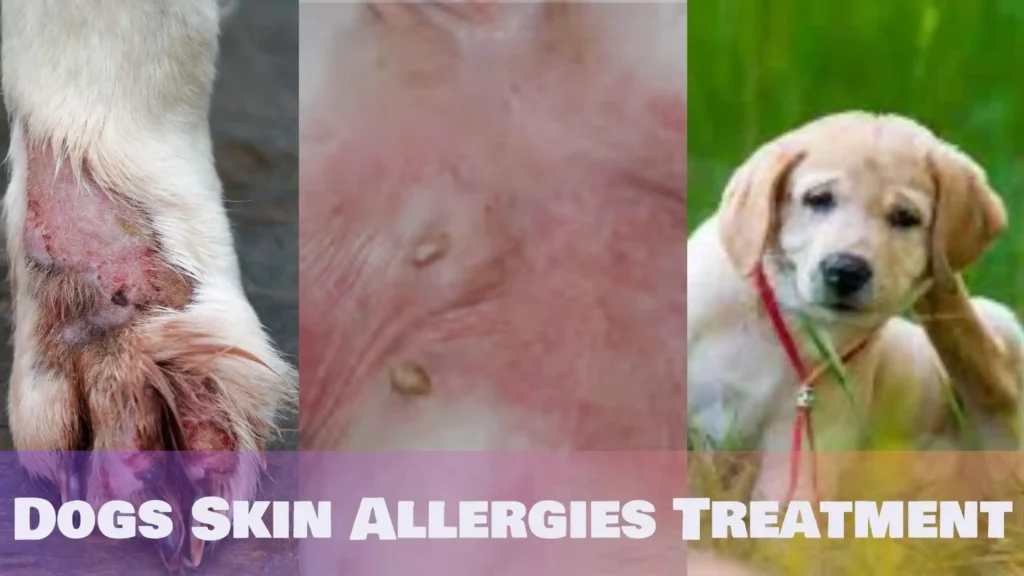
Understanding Dogs Skin Allergies Treatment Causes and Symptoms
What are Skin Allergies in Dogs?
The causes of skin allergy in dogs include a situation where the immune system of the animals overreacts to a particular substance or allergen. These are food-borne allergens, environmental allergens, and parasitic allergens such as fleas among others.
When the immune system identifies such allergens it triggers the release of chemicals that in turn cause itchy sensations among other symptoms.
Common Signs and Symptoms of Skin Allergies in Dogs

There are different types of skin allergies and they can affect a dog and the severity of the skin allergy symptoms can differ.
Common signs include:
- Excessive scratching and licking: This is evidenced by the fact that dogs scratch and lick the affected areas in a bid to relieve themselves from itching.
- Redness and inflammation: A skin rash may manifest by making the skin appear red, inflamed, or irritated.
- Hot spots: Although they are relatively minor skin conditions, they are sore and can sometimes ooze.
- Hair loss: From the constant scratching and biting, skin inflammation results in the development of alopecia or patchiness due to hair loss.
- Scabs and sores: Chronic scratching or biting may lead to the formation of open sores as well as scabs.
Types of Allergies in Dogs
Basic knowledge about allergy types, Dogs Skin Allergies Treatment, and categories in dogs is significant to be able to treat it properly and avoid severe consequences. There are many causes of skin diseases in dogs, they may include foods, the surroundings, fleas, or physical touch with certain items.
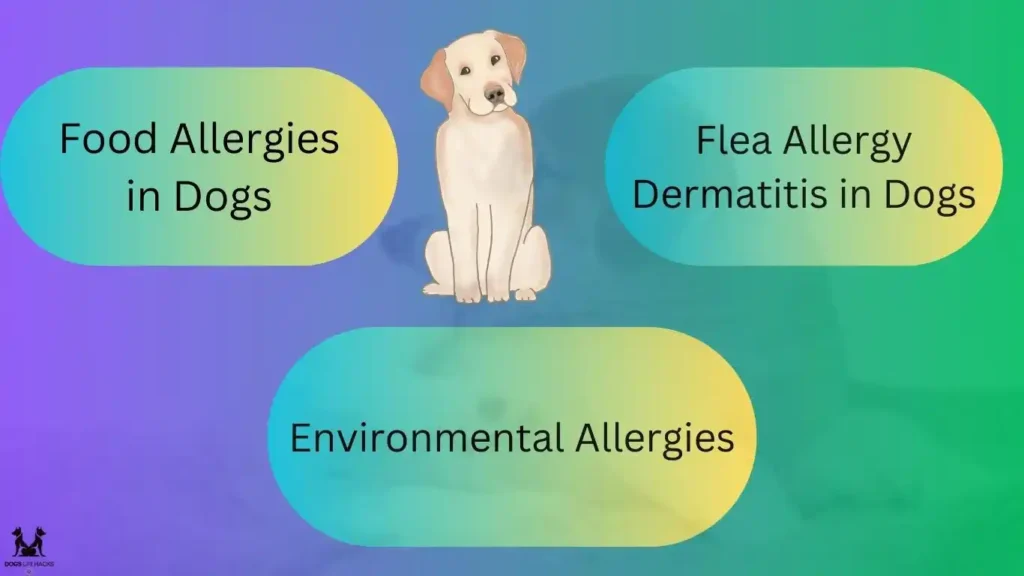
Let’s explore the main types of allergies in dogs:
Food Allergies in Dogs
Food allergies are a condition whereby the body of a dog attacks specific proteins found in the diet of the animal. The main offenders are meat, especially beef and chicken, dairy products, and grains.
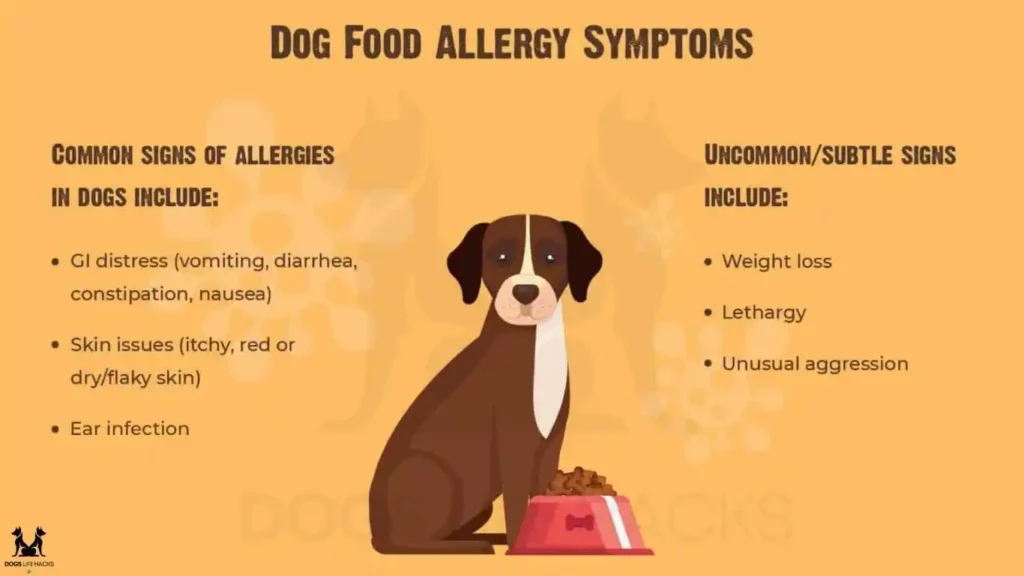
Dogs with food allergies may show symptoms like:
- Itching especially one that persists for many days usually around the head region particularly the ears, paws, and the face.
- Vomiting or Diarrhea Gastrointestinal is a phrase used loosely to refer to the ailment, organ, or disease of the digestive system.
- Infections of the ears that appear frequently.
The most common ways of handling the problem include the process of elimination, where the potential allergens are withdrawn from the diet of the dog and then it is fed with them incrementally in an attempt to pinpoint the trigger.
Another thing that can be done is feeding a hypoallergenic dog food as well as developing a novel protein diet as well.
Environmental Allergies: Pollens, Molds, and Dust
Seasonal allergic eczema or atopic dermatitis is a type of eczema that is occasioned by pollen, mold, dust mite, and grass. Dogs with environmental allergies will more than likely have seasonal itching, but some dogs may itch all year round.
- Symptoms include Rheumatalgia, rhinitis and conjunctivitis, pruritus, and otitis.
- Commonly affected areas: Areas that most reacted to the flicker rate change were the ears, the belly, paws, and the groin area.
These include proper grooming, the use of air conditioners or purifiers, antihistamines, and the use of specific shampoos. Allergy shots or immunotherapy are also long-term remedies for treating dogs skin allergies treatment.
Flea Allergy Dermatitis in Dogs
Flea allergy dermatitis (FAD) can be considered as an itchy skin disease in dogs which is potentially the most widespread of all skin conditions. Flea bites cause flea allergy dermatitis and show that your dog is sensitive to flea saliva in particular.
- Symptoms: Redness, itching, hair shedding, inflammation and rashes, injuries in the form of sores or what is commonly known as hot spots.
- Affected Areas: Towards the end of the tail, the back limbs, and around the cervical region.
Flea control is something that needs to be managed well. Take your pet to the veterinarian where you can get medications such as topical treatments, oral tablets, and flea collars. Vacuuming the floor as well as washing bedding every day also assist in the management of FAD.
Contact Allergies and Chemical Sensitivities
Contact allergies are caused by a dog’s skin contact with certain plant, chemical, or fiber materials that appear to irritate the skin of the dog. Some of the most typical causes of allergies are the products used for cleaning the carpets, specific types of soap, or some types of trees such as the poison ivy tree.
- Symptoms: Small areas of skin may become itchy, red, or swollen or form small blisters with clear fluid.
- Affected Areas: Paw, muzzle, and belly areas.
The first and foremost action to reduce exposure risk is to find out the cause of the allergen and do away with it. Using hypoallergenic shampoos to wash the affected area and applying topical application may relieve the skin condition.
Identifying the Symptoms of Allergies in Dogs
To treat allergies in dogs their owners must be aware of some of the signs which may indicate that they are suffering from allergies. Reaction can be mild or severe, and it can affect your dog’s dermis layer, intestine, or respiratory tract.
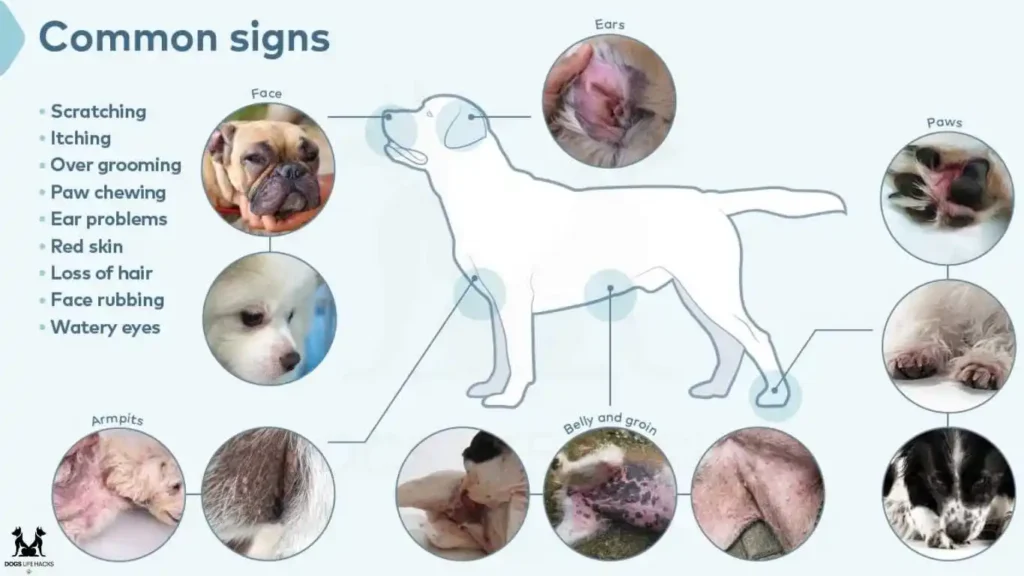
Early Signs of Allergic Reactions
Preventing allergic reactions in dogs is particularly important to avoid severe symptoms and ensure early diagnosis. Some of the early signs to look out for include:
- Excessive scratching or licking: For example behind the ears if they are a dog, at the paws if they are a cat, or at the belly of any animal.
- Frequent sneezing or coughing: These may form a respiratory allergy.
- Eye discharge or redness: Signal of an early skin allergy that indicates an environmental or contact allergy in the patient’s skin.
- Recurring ear infections: Ear scratching in dogs may also be uncomfortable or painful which is why dogs with this condition may have an allergy.
Common Skin Symptoms: Redness, Itching, and Rashes
The most apparent symptoms of dog skin allergies are skin-related, such as:
- Redness and inflammation: The skin can be red and might feel like it has a rash or is puffy.
- Itchy skin or dermatitis: Recurrent or continuous scratching, biting, or chewing.
- Rashes or hives: Small red elevations of the skin that are smooth on the surface and which may be warm to the touch.
Common skin complaints are reported for the ears, paws, abdomen, and genitals. If left exposed these areas can remain wet and are predisposed to bacterial and fungal colonization.
Severe Allergic Reactions: Anaphylaxis and Facial Edema
Occasionally, dogs can have an anaphylactic response to the chemical, which is a medical emergency. These may include:

- Anaphylaxis: A serious threatening condition that presents with symptoms such as breathing problems, vomiting, and low blood pressure. Immediate intervention is critical.
- Facial Edema: Expression changes: Sluggish and boggy and hinges. Insects bite and sting, particularly around the eyes and muzzle.
Action Steps: If you think your pet has anaphylaxis or facial edema, please take your pet to the emergency hospital immediately.
Common Allergic Reactions in Dogs and How to Manage Them
The next step after you have checked if your dog indeed has allergies is to treat your dog’s condition and reactions. Different allergies come with different responses and thus need to be handled differently. Here’s a closer look at common allergic reactions in dogs and the best ways to manage them:
Allergic Dermatitis: What Is It and How to Treat It?
The term ‘allergic dermatitis’ is used to describe several different skin reactions which are all allergic. The signs that define it include itching, redness, and inflammation that may not fade even after several days of Dogs Skin Allergies Treatment.
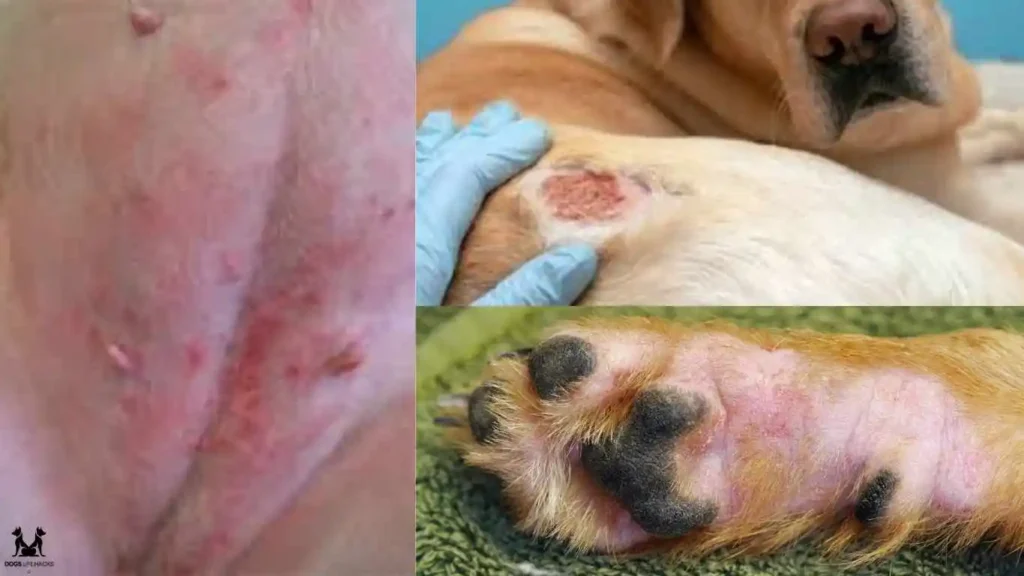
- Symptoms: Some of the symptoms include skin dryness, rashes, skin peeling, inflammation, and increased sensitivity to touch.
- Management: When an outbreak occurs the disease can be managed through topical agents like corticosteroid creams which help to reduce inflammation. This can be treated by the use of oral agents such as antihistamines or even corticosteroids for seasoned relief. Shampooing the hair daily with medicated or hypoallergenic shampoos may also control the skin condition.
Urticaria or Hives: Causes, Symptoms, and Treatment Options
Urticaria also known as hives, present as raised skin rashes and often occur due to bite/sting or food intolerance in dogs.
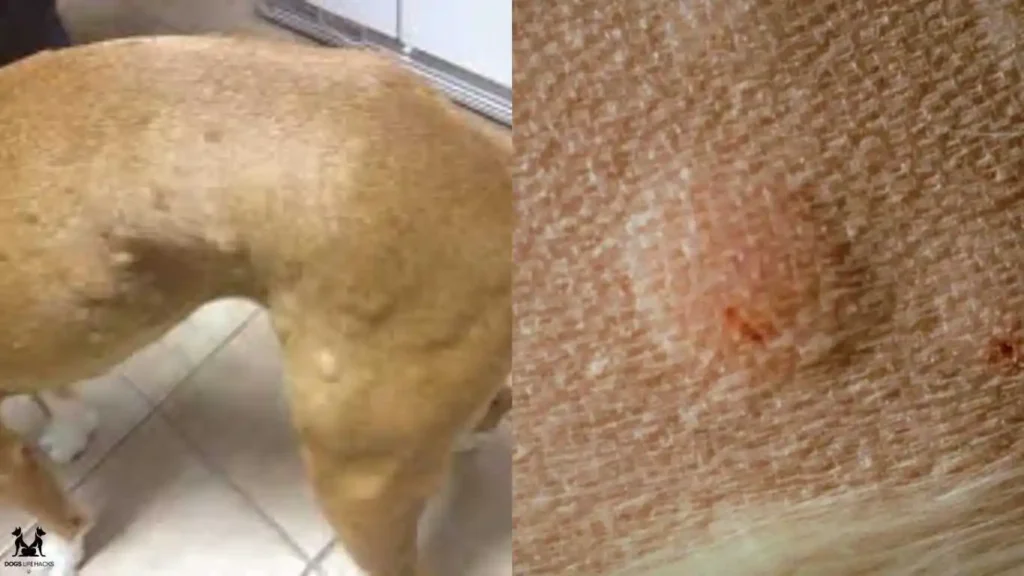
- Symptoms: They are round swellings that are raised from the surface of the skin and can develop on any part of the body.
- Treatment: Most of them are self-limiting diseases and tend to improve by themselves. However, you will be glad to know that antihistamines can help. In severe cases, corticosteroids or epinephrine may be used.
Managing Severe Reactions: Anaphylactic Shock in Dogs
Anaphylactic shock is one of the severe forms of allergic reactions that have the potential to be fatal. It commonly develops following exposure to an allergen, this may include stings from insects, certain medications, or vaccines.
- Symptoms: Faster respiration, vomiting, diarrhea, chance of gum foaming, and collapse state.
- Immediate Action: Give an injection of epinephrine if available otherwise just rush the patient to the nearest vet clinic. Augmentative care like; the administration of intravenous fluids and oxygen may be needed.
Diagnosing Skin Allergies in Dogs
It is important that when dealing with dog skin allergies and dogs skin allergies treatment, one consults with a veterinarian for a proper diagnosis. This is why when one has such symptoms, one needs to visit the doctor for a professional diagnosis. Here’s what to expect during a vet visit for diagnosing skin allergies:
Allergy Testing for Dogs: Blood Tests and Intradermal Skin Testing
If your veterinarian wants to know which agents trigger a reaction in your dog, then he may advise the testing process.
The two most common types are:
- Blood Tests: Blood tests measure the level of allergen in the patient’s system as well as the presence of antibodies. However, they are less invasive than the latter and can be as accurate as skin tests.
- Intradermal Skin Testing: Thought of as the best, this entails placement of a tiny drop of possible allergic agents to the skin and then monitoring the response. It is normally more accurate but it may only be done if the animal is under anesthesia and the vet dermatologist is called upon.
How to Identify Specific Allergens Affecting Your Dog
It is therefore important that the doctor identifies the specific antigen so that you can be treated appropriately. Besides allergy tests, the vet may use a combination of the following methods:
- Elimination Diet Trials: This is used in diagnosing food allergy, it involves eliminating foods that you think your dog could be allergic to and then instituting them back into the dog’s diet.
- Physical Examination: The vet may if certain symptoms such as rashes on the skin, ear infections,s or hot spots are likely to be associated with certain allergy triggers.
- Medical History Review: An astute medical history of your dog’s symptoms and pattern of living and any other allergic reaction could give some direction of what triggers the reaction.
Effective Treatments for Dog Skin Allergies
Dog skin allergies are systematic disorders, which once diagnosed require the use of orthodox medicine alongside other remedies.
Here’s a comprehensive guide to various dogs skin allergies treatment options available:

Medications for Allergy Relief: Antihistamines, Steroids, and Immunotherapy
Medications can provide immediate and long-term relief for dogs suffering from allergies:
- Antihistamines: They are usually the initial instruments used to manage contact with milder forms of allergies. They help in fading out the itching signs and redness but such anti-inflammatory drugs do not assist all dogs. Examples of antihistamine drugs include; Benadryl (diphenhydramine) and Claritin (loratadine).
- Steroids: For more serious anaphylactic reactions, a doctor may decide that corticosteroids such as prednisone are appropriate. Although they are quite useful, steroids are administered for a limited period because of their side effects.
- Immunotherapy: In chronic cases of allergies, your vet may recommend the administration of allergy shots or sublingual drops (immunotherapy). It is another method in which your dog is slowly introduced to small portions of the allergen to develop an immune threshold.
Natural Remedies for Dog Allergies: Aloe Vera, Oatmeal Baths, and Coconut Oil
Natural remedies can complement traditional treatments and provide additional relief:
- Aloe Vera: Due to its critical feature for calming effects, the application of aloe vera gel will help to eliminate itching and inflammation.
- Oatmeal Baths: Oatmeal’s skin benefits were benefiting from oat baths on the skin and it was recommended to take them regularly for mild allergic manifestations.
- Coconut Oil: Coconut oil contains fatty acids that when massaged onto the skin keep it soft and dry and act as anti-itch agents.
The Role of Omega-3 Fatty Acids and Dietary Supplements
One should incorporate Omega-3 fatty acids into the dog’s diet through fish oil or any other source to minimize inflammation as a result of skin allergies that may be caused by pollen. Other beneficial supplements include:
- Probiotics: Support the digestive system to enhance the performance of the general immune system.
- Quercetin: An antihistaminic and an antioxidant that may help curb allergic reactions and its symptoms.
Managing Canine Atopic Dermatitis
Canine atopic dermatitis is a long-term recurring disease that is characterized by an inflammation of the skin in response to exposure to certain environmental factors. In dealing with this condition, medication, diet /nutrition and environmental modification are some of the measures that should be observed.
What is Atopic Dermatitis in Dogs?
Atopic dermatitis is an allergic-like inherited inflammatory skin disease. It is an inflammatory disease that is attributed to hypersensitivity to antigens from the environment including dust mites, pollen, and mold spores.
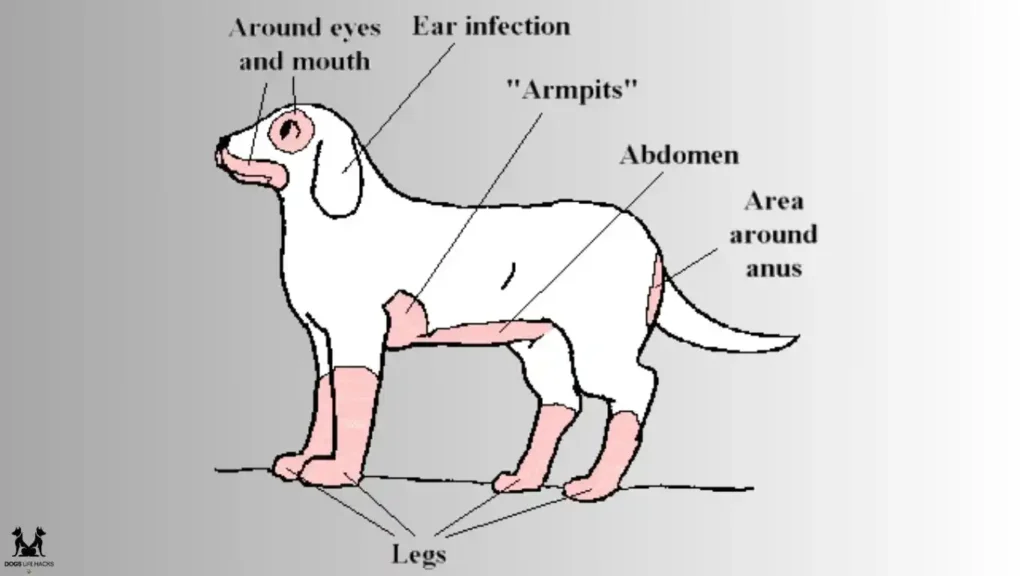
- Symptoms: Some of the symptoms may include constant scratching, redness, scaly skin, ear infections, and skin infections also known as hot spots.
- Affected Areas: Some parts which he usually does bite include paws, face, belly, and ears.
Dog Breeds Prone to Canine Atopic Dermatitis
Some breeds are more prone to developing atopic dermatitis due to their genetic makeup:
- Golden Retrievers: They suffer from allergic skin conditions and so they have been known to develop skin allergies.
- Labrador Retrievers: Most of them are always allergic to the environment or food products.
- Bulldogs and Boxers: Suffers from skin allergies and dermatitis most of the time.
- West Highland White Terriers and Poodles: These breeds are also good examples of breeds that are highly susceptible.
Signs and Symptoms of Atopic Dermatitis in Dogs
Identifying the signs of atopic dermatitis can help you manage the condition more effectively:
- Persistent Scratching and Licking: On the paws as well as the face and belly regions in particular.
- Recurrent Ear Infections: One of them is rather frequently encountered and can be easily confused with problems in the ears only.
- Red, Inflamed Skin: May cause skin to become thicker and Hair loss if not treated.
Treatment Options for Atopic Dermatitis: Medications and Lifestyle Changes
Effective management of canine atopic dermatitis involves multiple strategies:
- Medications: Other choices include antihistamines and corticosteroids together with other modern and effective drugs such as Apoquel and Cytopoint which mainly deal with the issue of itching.
- Lifestyle Changes: Frequency bathing, use of hypoallergenic fabrics for bedding, and having air purifying equipment can minimize allergens in the living space.
- Topical Treatments: Moisturizers, including shampoos, creams, and sprays for atopic dermatitis can be said to be localized treatment.
Advanced Allergy Treatments: Alternative and Holistic Approaches
Several holistic remedies can be of help in managing allergies hence worth for dog owners who seek new ways of handling the problem. These methods can be offered as additional to the traditional approaches or can be used independently in mild cases.
Acupuncture Therapy for Dog Allergies: How It Works
Acupuncture is becoming increasingly popular in veterinary medicine, especially for managing allergies and dogs skin allergies treatment:
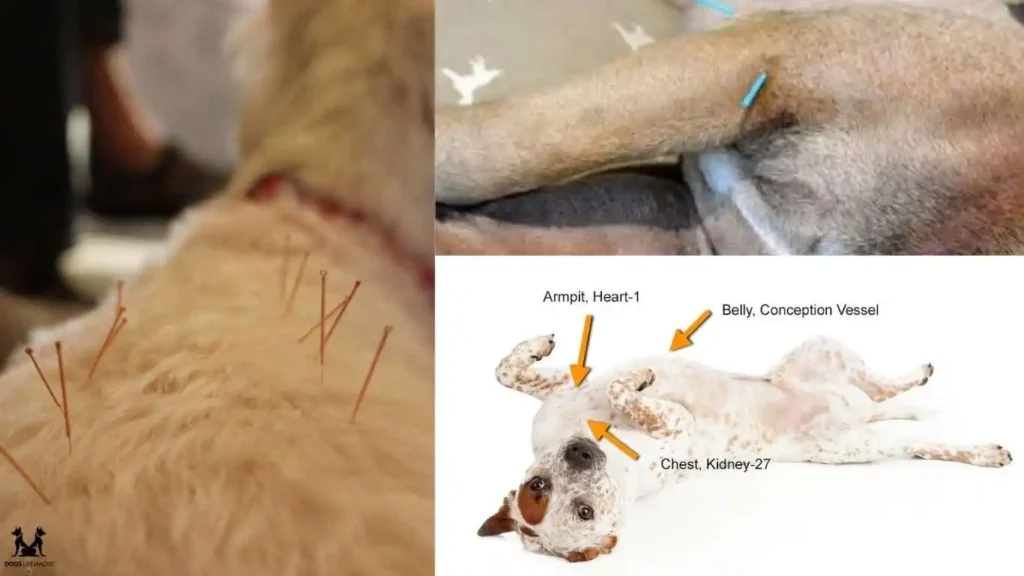
- What It Is: Acupuncture can be defined as a traditional Chinese technique with the insertion of very thin needles into well-defined points of the body of a dog for healing purposes apart from reducing inflammation.
- How It Helps: Chamomile is particularly known for its properties that may assist in regulating immune reactions, eliminate itching, and enhance the skin condition.
- Application: In most cases, a certified veterinary acupuncturist will carry out several sessions to determine efficacy.
The Use of Herbal Supplements and Homeopathy in Treating Allergies
Herbal supplements and homeopathic remedies are often used to support a dog’s immune system and Dogs Skin Allergies Treatment naturally:
- Herbal Supplements: These natural herbs include nettle leaf, quercetin, and turmeric as they have some properties that naturally remove inflammation in the body thus minimizing allergic reactions.
- Homeopathy: Allergic skin disease can be treated by homeopathic medicine like Apis mellifica and Sulphur. To use them efficiently and safely, consulting a holistic vet will be of great benefit.
Note
It should be taken with a word of warning that you should always consult your veterinarian before trying any holistic treatments or remedies as these may in some circumstances harm your dog.
Preventing Skin Allergies in Dogs: Tips for Dog Owners
The Dogs Skin Allergies Treatment entails early measures to reduce contact with potential allergens as well as healthy skin. Here are some effective tips for dog owners to help prevent skin allergies:
Regular Grooming and Bathing to Minimize Allergens
Regular grooming helps to keep allergens like pollen, dust, and mold off your dog’s skin and coat:
- Brushing: Brushing also regularly removes dead skin cells, fur, dander, and other allergens that may be in the environment. Select a brush that is appropriate to the coat of the dog that you own.
- Bathing: Clean the dog with hypoallergenic baby shampoo and bathe the dog frequently to wash off all the allergens. Do not over-bathe since this will remove the oils from the skin naturally.
Choosing Hypoallergenic Diets and Safe Household Products
Diet and household products play a significant role in managing and preventing allergies:
- Hypoallergenic Diets: The skin disease may require a change in diet by using a skin-sensitive diet or a diet that contains a new protein. This can go a long way in minimizing food allergies thus ensuring that individuals stay healthy at all times.
- Safe Household Products: Use non-toxic, hypoallergenic cleaning supplies, and do not use any chemicals that may harm the skin of your canine companion. When buying products for your dog to lay on or products to use in grooming him choose those that are preferably ned or those with very little scent.
Preventive Measures for Flea Allergy Dermatitis
Preventing flea infestations is crucial for dogs prone to flea allergy dermatitis:
- Flea Control: Some key recommendations for protecting the pets from fleas include; topical flea repellents, oral flea repellents, or flea collars. Bath your home environment with flea repellents such as sprays or even foggers every once in a while.
- Regular Checks: Observe your dog’s skin and fur often, especially when the flea season is around the corner.
If you follow the above preventative measures then you would not only cut your chances of developing skin allergies in your dog but improve the chances of managing them adequately.
Dealing with Dogs Skin Allergies Treatment involves the identification of symptoms, types of allergies, and ways to treat them. Conventional medication alone and sometimes even vaccines may not give the needed result or may not help at all, but having a customized plan helps the dog live a much more comfortable life.
Frequently Asked Questions
Is Zyrtec or Benadryl better for dogs?
Zyrtec is now the first choice of many dog owners because of its dosing regimen, which makes it quite easy to use. While patients’ responses to antihistamines can differ considerably, our clients this year are getting a higher response level compared to Benedryl.
What does a dog allergy rash look like?
What do skin eruptions or a rash appear as on a dog? Skin reactions may turn red, become bumpy or swollen, or develop a raised appearance that is similar to a welt. There could be hair loss and areas known as hot spots, the areas of skin that are sore red and may be oozing.
What does dermatitis look like on a dog?
Dermatitis is a skin condition that develops in various forms and mostly, the skin presents a red and inflamed area that may be itchy and sensitive to touches; many times, these affected areas of the skin present with lesions.
What is the best thing for dog skin irritation?
It has also been demonstrated that colloidal oatmeal may contain substances with natural anti-inflammatory properties useful in relieving redness, swelling, and itching. In addition, it is 100% non-toxic which means testers will not suffer any adverse side effects from it.
What ointment can I put on my dog for itching?
This relief may just be located in hydrocortisone cream for your dog which has to be gotten from your vet. It can also be used on dogs but you must know that there are risks associated with the use of the product.
Related Topics
